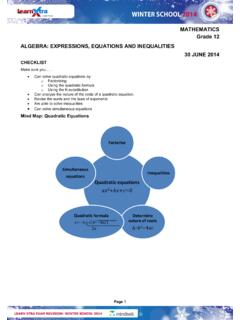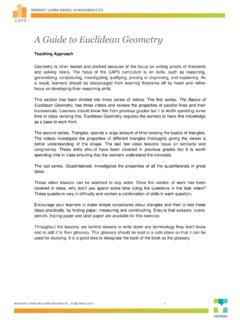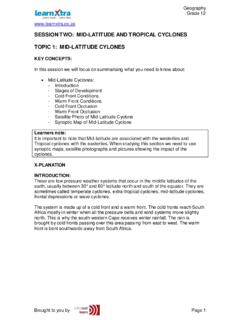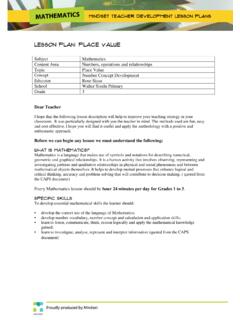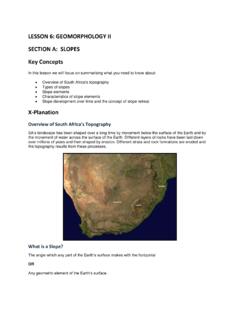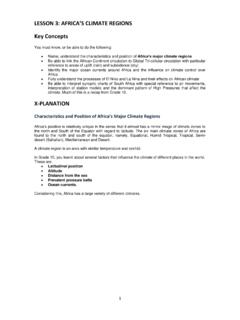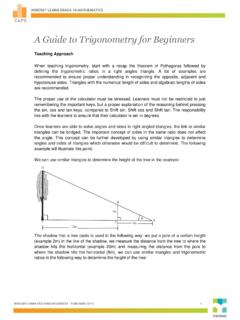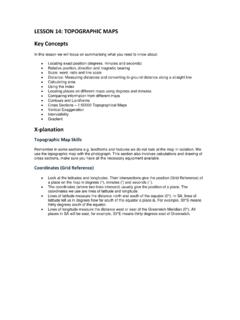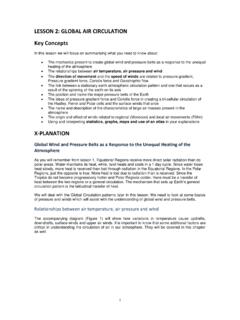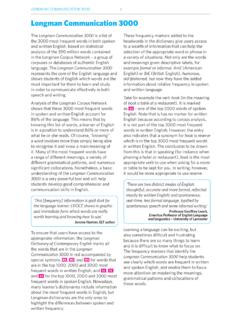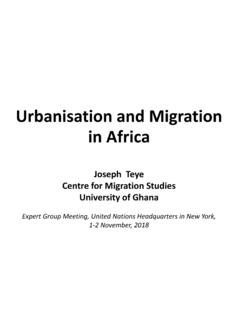Transcription of A Guide to Number Patterns, Sequences and Series
1 A Guide to Number patterns , Sequences and Series Teaching Approach This Series covers revision of linear Number patterns , introduction to quadratic Sequences and finding the nth term. Pupils need to have a good understanding of all Number patterns and simultaneous equations from grade 10. In grade 11, the focus is on quadratic Number patterns , pupils must be able to find any term in the sequence, the general term and the position of any term in the sequence. It may be necessary to revise simultaneous equations before the lesson on finding the nth term and also to remind pupils of how to solve a quadratic equation. There are different methods to find the nth term of a quadratic sequence we show the method that pupils usually find the easiest to understand first, that is the method of simultaneous equations.
2 For weaker pupils this is probably the best method to use. We also show the method of the first term of the first difference is equivalent to 3a+b as an alternate method for those pupils who are able to remember theory quite well. This is a relatively short but important section, pupils often forget all about quadratic Sequences when they get to grade 12 so it is important to continuously remind them of this section in tests and exam questions. Video Summaries Some videos have a PAUSE moment, at which point the teacher or learner can choose to pause the video and try to answer the question posed or calculate the answer to the problem under discussion. Once the video starts again, the answer to the question or the right answer to the calculation is given.
3 Mindset suggests a Number of ways to use the video lessons. These include: Watch or show a lesson as an introduction to a lesson Watch of show a lesson after a lesson, as a summary or as a way of adding in some interesting real-life applications or practical aspects Design a worksheet or set of questions about one video lesson. Then ask learners to watch a video related to the lesson and to complete the worksheet or questions, either in groups or individually Worksheets and questions based on video lessons can be used as short assessments or exercises Ask learners to watch a particular video lesson for homework (in the school library or on the website, depending on how the material is available) as preparation for the next days lesson; if desired, learners can be given specific questions to answer in preparation for the next day s lesson 1.
4 Revision of Linear Number patterns In this lesson we revise all the concepts done in grade 10 using the general term Tn=an+b. Pupils must be able to find any term in the sequence, the position of any term and the nth term of linear Number patterns . 2. Quadratic Number patterns In this lesson the general form of a quadratic sequence is introduced, learners are taught how to recognise a quadratic sequence by finding a constant second difference. 3. The General Term of Quadratic Sequence We develop a method to find the general term of a quadratic sequence using simultaneous equations and the fact that the value of a is a half of the second difference in any quadratic sequence. 4. Determining the General Term of a Quadratic Sequence In this lesson we look at another method to find the nth term of a quadratic sequence.
5 Resource Material Resource materials are a list of links available to teachers and learners to enhance their experience of the subject matter. They are not necessarily CAPS aligned and need to be used with discretion. 1. Revision of Linear Number patterns Exercises using the formula Tn=an+b. Linear Number Sequences free videos. 2. Quadratic Number patterns How to decide whether a Number pattern is a quadratic or linear 3. The General Term of Quadratic Sequence Textbook that explains quadratic Sequences . Worksheet on quadratic Sequences . Examples on quadratic Sequences . 4. Determining the General Term of a Quadratic Sequence Video showing how to find the nth term. A video on factorising with rational and negative exponents Worksheets, activity and tutorial on quadratic Sequences .
6 Task Question 1 Find the 40th term in the sequence: 5; 2; -1; Question 2 The seating of a sports stadium is arranged so that the first row has 15 seats, the second row has 19 seats; the third row has 23 seats and so on. Calculate how many seats are in the twenty-fifth row. Question 3 Which term in the sequence 1; -2; -5; .. is equal to -32? Question 4 In each case the general term is given write down the first three terms of the sequence: Question 5 Write down the next three terms of the sequence: 6; 4; 0; -6; .. Question 6 Find the formula for the general term of the sequence: 6; 10; 14; 18; .. Question 7 Anne and Jerry look at the following pattern: Pattern 1 Pattern 2 Pattern 3 Anne says she can work out the general formula for the Number of dots by taking the Number of columns in each pattern and multiplying it by the Number of rows.
7 Jerry says if he increases the pattern Number by one, squares that and then subtracts the pattern Number increased by one he will get the general formula. Who is correct? (Justify your answer) Question 8 Find the general term and hence the Number of terms in the sequence: 5; 10; 17; 26; ..10202 Question 9 How many terms are in the sequence If Question 10 Which term in the sequence below is equal to six: Task Answers Question 1 d= -3 General term will be linear. Substitute any term value to find b. T(1)=5 Question 2 15; 19; 23; .. a=d=4 Substitute T (2) =19 There are 111 seats in the 25th row.
8 Question 3 1; -2; -5 d= -3 Question 4 Question 5 6; 4; 0; -6; .. -2 -4 -6 -2 -2 T5= -14 T6=-24 T7= -36 Question 6 6; 4; 0; -6; .. -2 -4 -6 -2 -2 Sub (1) in (2) And b =7-6=1 Question 7 Anne s general term: Jerry s general term: Both are correct.
9 Question 8 5; 10; 17; 26; ..10202 5 7 9 2 2 And c=2 There are 100 terms in the sequence. Question 9 So there are ten terms in the sequence. Question 10 Acknowledgements Mindset Learn Executive Head Dylan Busa Content Manager Classroom Resources Jenny Lamont Content Coordinator Classroom Resources Helen Robertson Content Administrator Agness Munthali Content Developer Natashia Bearam Content Reviewer Ghairoeniesa Jacobs Produced for Mindset Learn by Traffic Facilities Manager Belinda Renney Facilities Coordinator Cezanne Scheepers Director Alriette Gibbs Editor Nonhlanhla Nxumalo Belinda Renney Presenter Katleho Serobe Studio Crew Abram Tjale Graphics Wayne Sanderson Credits This resource is licensed under a Attribution-Share Alike South Africa licence.
10 When using this resource please attribute Mindset as indicated
